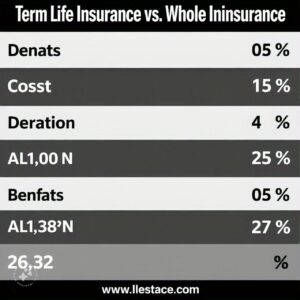Introduction
Life insurance plays a critical role in financial planning, offering peace of mind and financial security to your loved ones. However, selecting the right type of life insurance can be overwhelming. Among the many options available, term life insurance and whole life insurance are two of the most popular choices. But how do these two options differ, and which one suits your needs best? Here, we’ll delve deep into the distinctions between these two types of life insurance, covering everything from cost and coverage to benefits and drawbacks.
What is Term Life Insurance?
Term life insurance is a type of life insurance policy that provides coverage for a specified period, usually ranging from 10 to 30 years. If the insured individual passes away during the policy term, the designated beneficiaries receive a death benefit.

Key Features of Term Life Insurance
- Fixed Coverage Period: Offers coverage for a specific term, such as 20 or 30 years.
- Affordable Premiums: Term policies generally have lower premiums compared to whole life insurance.
- No Cash Value: Unlike whole life insurance, term policies do not build cash value.
- Renewable Options: Many term policies allow renewal after the term expires, though at higher premiums.
Advantages of Term Life Insurance
- Cost-effective, especially for young policyholders.
- Simple to understand and manage.
- Ideal for temporary needs like mortgage payments or education expenses.
Drawbacks of Term Life Insurance
- Coverage ends once the term expires unless renewed.
- No investment or savings component.
What is Whole Life Insurance?
Whole life insurance, as the name suggests, provides lifetime coverage. Unlike term policies, whole life insurance includes a savings component known as cash value, which accumulates over time.
Key Features of Whole Life Insurance
- Lifetime Coverage: Protects you as long as premiums are paid.
- Cash Value Component: Allows policyholders to borrow or withdraw funds during their lifetime.
- Fixed Premiums: Premium rates remain consistent throughout the policy.
- Tax Benefits: The cash value grows on a tax-deferred basis.
Advantages of Whole Life Insurance
- Provides lifelong financial security.
- Accumulates savings, offering a source of funds during emergencies.
- Tax-free death benefit to beneficiaries.
Drawbacks of Whole Life Insurance
- Higher premiums compared to term policies.
- Less flexibility in coverage adjustments.
- Complexity due to the investment aspect.
Factors to Consider When Choosing Between Term and Whole Life Insurance
1. Budget and Affordability
If affordability is your primary concern, term life insurance may be the better option due to its lower premiums.
2. Duration of Coverage Needed
- Short-term financial goals (e.g., paying off a mortgage): Opt for term life insurance.
- Long-term needs (e.g., estate planning): Whole life insurance is a better choice.
3. Investment Preferences
For individuals seeking a savings component with tax benefits, whole life insurance offers dual benefits of protection and investment.
4. Financial Goals and Flexibility
Consider whether you need a policy that adapts to your changing financial circumstances. Term insurance is simpler, while whole life insurance is more rigid but comprehensive.
Conclusion
Understanding the differences between term life insurance and whole life insurance is essential to making an informed decision. While term life insurance suits those seeking cost-effective, temporary coverage, whole life insurance is better for individuals seeking lifelong protection with a savings component. Ultimately, the choice depends on your financial goals, coverage needs, and budget. Consulting with a financial advisor can further help you select the best policy tailored to your unique situation.

